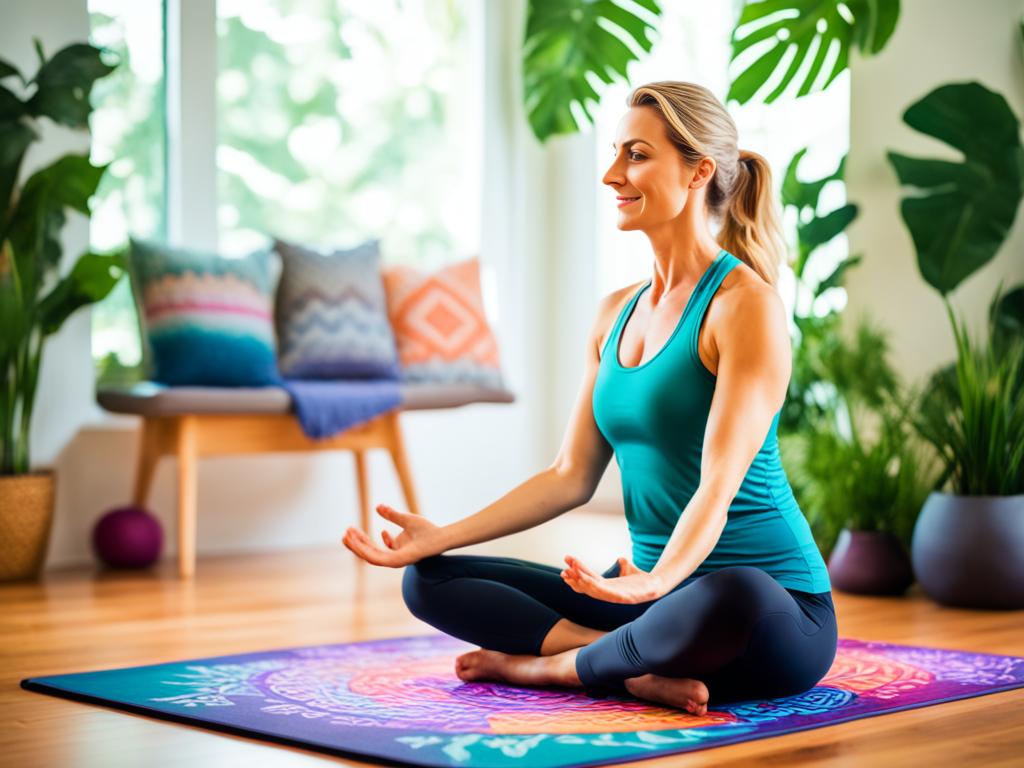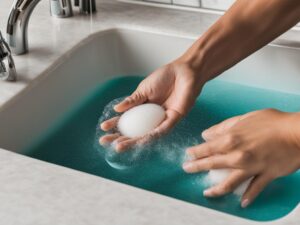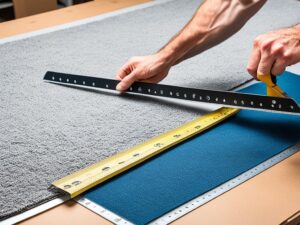When it comes to enhancing your yoga practice, having the right accessories can make all the difference. Two popular options, the yoga rug and the yoga mat, offer unique features and benefits. Deciding which one is best for you depends on your personal preferences and specific needs. In this article, we will compare the yoga rug and yoga mat, highlighting their differences and exploring the advantages they bring to your practice.
Key Takeaways:
- Understanding the differences between a yoga rug and a yoga mat can help you make an informed decision for your practice.
- Yoga mats provide stability, comfort, and a non-slip surface, making them ideal for various exercises beyond yoga.
- Yoga rugs offer a natural feel, eco-friendliness, and a connection to the origins of yoga.
- Combining a yoga rug and a yoga mat can provide extra cushioning, stability, and balance for certain poses.
- Your choice between a yoga rug and a yoga mat ultimately depends on factors such as durability, grip, alignment, and sustainability.
What is a Yoga Mat?
A yoga mat is a specially designed mat that provides traction, grip, and balance for your yoga practice. It offers a firm and stable surface to support your movements and provide comfort during your practice. But did you know that a yoga mat is not just limited to yoga sessions?
With its versatile design, a yoga mat can also be used for other exercises such as weight training, pilates, and meditation. Its cushioned and non-slip surface makes it ideal for various fitness activities. Whether you’re holding a plank position during weight training or practicing mindful meditation, a yoga mat enhances your overall experience.
Yoga mats come in different thicknesses, lengths, and materials to cater to individual needs. Some mats are lightweight and travel-friendly, making them perfect for on-the-go workouts. Others are more padded for added comfort during intense exercises.
Benefits of Using a Yoga Mat:
- Provides traction and grip to prevent slipping during poses
- Offers stability and balance for different exercises
- Cushions joints and reduces pressure on the body
- Acts as a barrier between you and the floor, maintaining hygiene
- Can be easily cleaned and maintained
“Using a yoga mat not only enhances your yoga practice but also offers support and comfort during various exercises.”
Whether you’re a beginner or an experienced practitioner, investing in a high-quality yoga mat is essential for a safe and enjoyable workout experience.
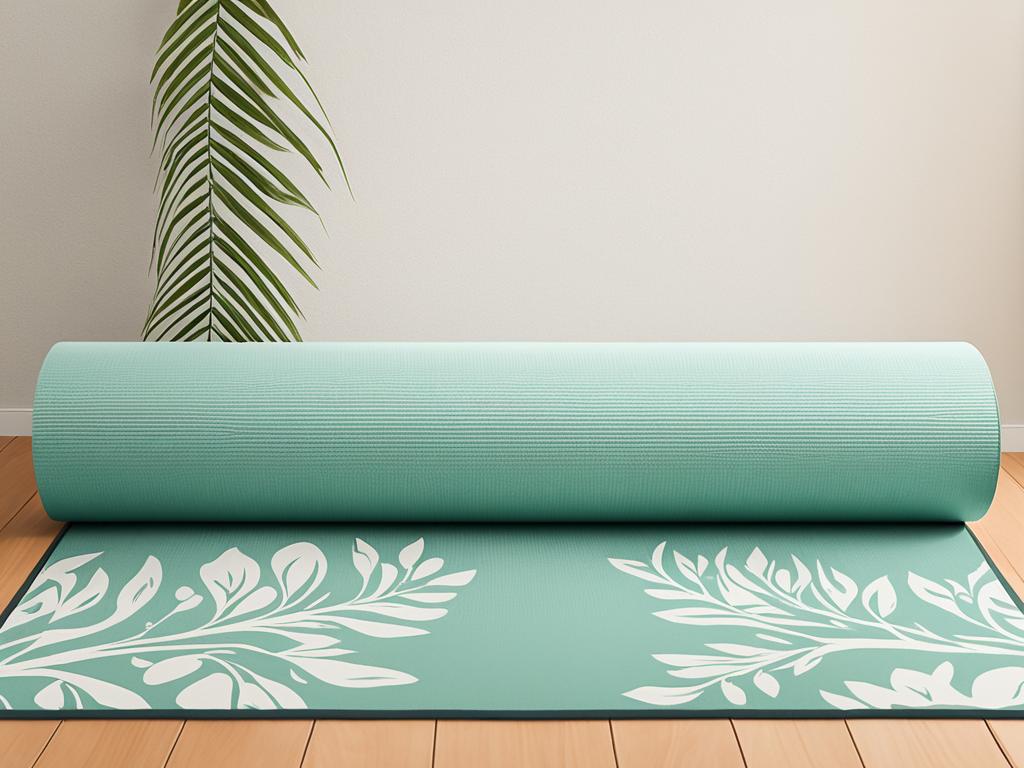
What is a Yoga Rug?
A yoga rug is a traditional floor mat that has been used in yoga practice for centuries. Originally used by ancient yoga practitioners, yoga rugs provide an extra layer of support between the feet or knees and the ground. Unlike modern yoga mats, which are made from various materials such as rubber or foam, yoga rugs have a more organic feel and are typically woven with organic cotton.
Yoga rugs are considered to be an eco-friendly alternative to yoga mats, as they are made from natural and sustainable materials. By choosing a yoga rug, you not only support your yoga practice but also contribute to a more environmentally conscious lifestyle.
Using a yoga rug during your practice allows you to connect with the origins of yoga and experience a more traditional approach. The texture and grip of a yoga rug provide stability and support, allowing you to maintain proper alignment in your poses.
Whether you’re a beginner or an experienced yogi, incorporating a yoga rug into your practice can enhance your overall experience. The combination of its supportive features and eco-friendly nature makes the yoga rug a compelling choice for practitioners seeking a more grounded and mindful practice.
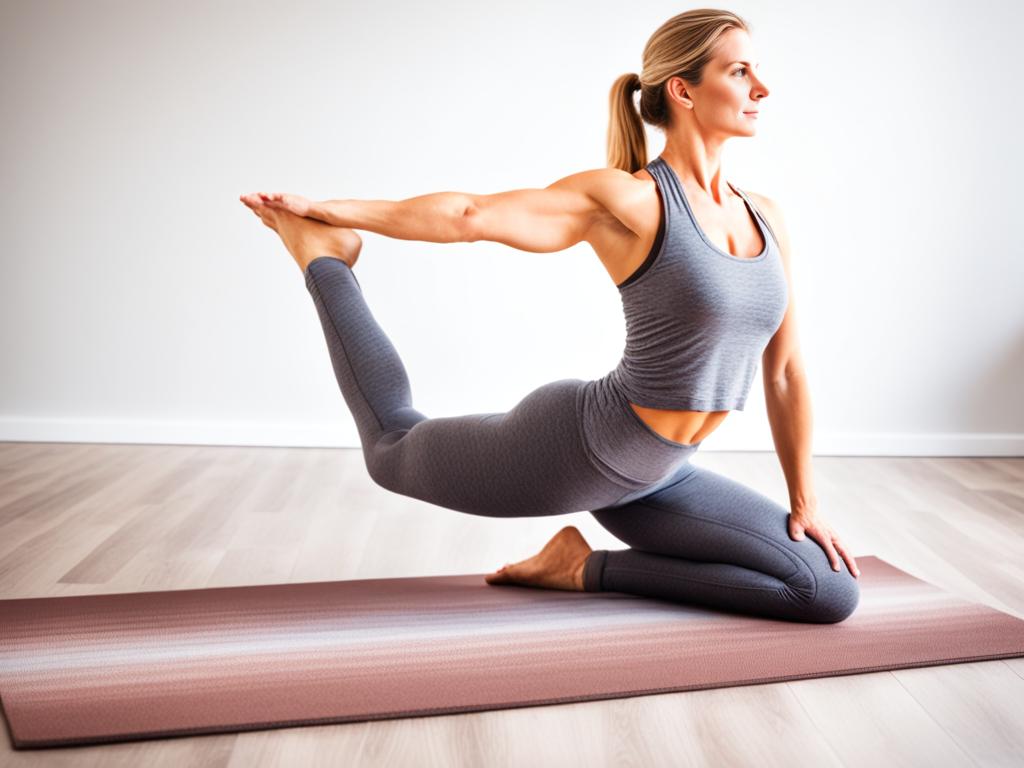
“Using a yoga rug adds an authentic touch to my practice, and I love the natural feel it provides. It’s like having a piece of history beneath me as I flow through my poses.” – Sarah, yoga enthusiast
The Differences Between a Yoga Mat and a Yoga Rug
When it comes to choosing between a yoga mat and a yoga rug, understanding their key differences can help you make an informed decision. These differences span across their materials, durability, thickness, portability, variety, and grip, ultimately impacting your yoga practice.
Materials
A yoga mat is typically made from a variety of materials such as rubber, foam, cork, or jute. These materials offer different levels of cushioning and support. On the other hand, a yoga rug is commonly woven with organic cotton. This organic material provides a traditional feel and is often preferred by those seeking a more natural and eco-friendly option.
Durability
Yoga rugs tend to be more durable compared to yoga mats. They can withstand machine washing, making them easier to clean and maintain. Yoga mats, on the other hand, often require hand cleaning and may wear out over time, especially with frequent use and intense practices.
Thickness
Yoga mats offer a wide range of thickness options, allowing you to choose the level of cushioning and support that suits your practice. This variety in thickness caters to different comfort preferences and can accommodate various yoga styles. Yoga rugs, however, provide a more limited variety in thickness, but their weave and material offer natural stability and support.
Portability
When it comes to portability, yoga mats are the preferred choice. They are lightweight and easy to roll up, making them convenient to carry to and from your yoga classes or when traveling. Yoga rugs, on the other hand, are bulkier and less portable due to their woven nature, typically requiring more space and effort to transport.
Variety
Yoga mats come in a wide variety of designs, colors, and patterns, allowing you to express your personal style and preferences. This variety adds a touch of personality to your yoga practice. Yoga rugs, however, have a more limited variety in terms of design. They often feature traditional patterns and earth tones, reflecting their historical significance and connection to the origins of yoga.
Grip
One of the key differences between yoga mats and yoga rugs is the level of grip they provide. Yoga mats are designed to offer superior grip to prevent slips and provide stability during poses. This makes them suitable for activities that require more traction, such as hot yoga or intense vinyasa flows. Yoga rugs, on the other hand, have a better natural grip due to their cotton weave, offering a secure feel and connection to the ground.
To help you visualize the differences between yoga mats and yoga rugs, here’s a comparison table:
| Differences | Yoga Mat | Yoga Rug |
|---|---|---|
| Materials | Rubber, foam, cork, or jute | Organic cotton |
| Durability | May wear out over time | More durable, can withstand machine washing |
| Thickness | Wide variety of options | More limited options |
| Portability | Lightweight and easy to carry | Less portable, bulkier |
| Variety | Wide range of designs and colors | More traditional patterns, limited variety |
| Grip | Designed for superior grip | Offers a better natural grip |
Understanding these differences will help you choose the yoga accessory that best suits your needs, preferences, and yoga practice.
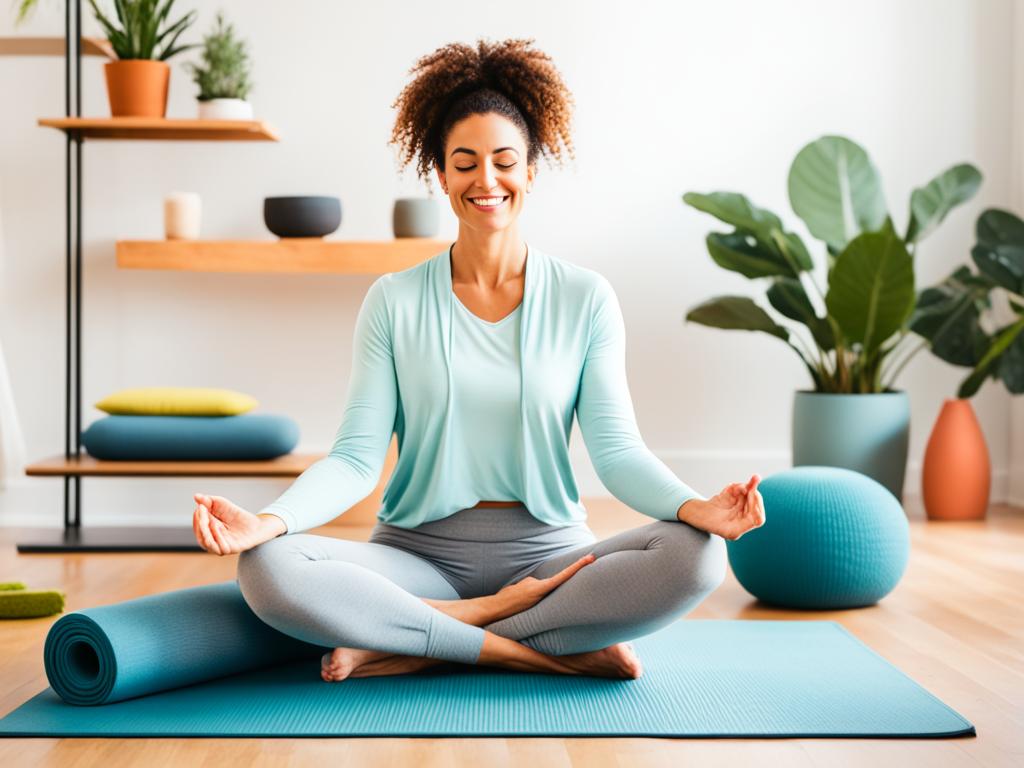
Next, we’ll explore the benefits of using a yoga mat, revealing how it enhances your stability, comfort, and overall yoga experience.
Benefits of a Yoga Mat
When it comes to your yoga practice, having the right equipment is essential. A yoga mat is a must-have accessory that offers numerous benefits to enhance your experience. Let’s explore the advantages of using a yoga mat:
Stability:
A yoga mat provides a stable surface for your practice, ensuring that you can maintain proper alignment and balance. The mat prevents your hands and feet from slipping, giving you the confidence to explore challenging poses without the fear of falling.
Comfort:
Yoga mats offer a comfortable cushioning for your joints, providing support and relieving pressure during your practice. The extra padding helps reduce strain on your knees, wrists, and elbows, allowing you to focus on your movements and achieve deeper stretches.
Non-Slip Surface:
One of the key features of a yoga mat is its non-slip surface. This feature is particularly beneficial for activities like hot yoga or vigorous movements that may cause perspiration. With a yoga mat, you can maintain a strong grip and stay in control throughout your practice.
Support:
A yoga mat offers excellent support for your body, enabling you to perform various poses with ease. The mat acts as a stable foundation, providing a level of comfort and confidence that allows you to fully immerse yourself in your practice.
With these benefits, it’s clear that a yoga mat is a valuable companion for any yogi. Experience the stability, comfort, non-slip surface, and support that a yoga mat provides, and take your practice to the next level.
Benefits of a Yoga Rug
When it comes to your yoga practice, using a yoga rug can offer a unique set of benefits that enhance your overall experience. From providing a natural feel to promoting sustainability, yoga rugs are a popular choice among practitioners seeking a deeper connection to tradition and nature.
One of the key advantages of using a yoga rug is the natural feel it brings to your practice. With its organic cotton construction, a yoga rug offers a tactile experience that some practitioners find enhances their connection to nature. The smooth texture of the rug against your skin creates a grounding sensation, allowing you to feel more connected to the Earth and your practice.
Another notable benefit of yoga rugs is their eco-friendly nature. Made from organic cotton, yoga rugs are a sustainable choice compared to yoga mats that are often made with synthetic materials. By choosing a yoga rug, you can reduce your environmental footprint and contribute to a healthier planet.
Furthermore, yoga rugs are free from chemicals and plastics, making them a skin-friendly option. When practicing on a yoga rug, you can rest assured that you are not exposing your skin to harmful toxins or allergens. This makes yoga rugs an ideal choice for individuals with sensitive skin or those who prioritize natural and non-toxic products.
| Benefits of a Yoga Rug |
|---|
| Natural feel and connection to nature |
| Eco-friendly and sustainable |
| Skin-friendly and free from chemicals |
Using Yoga Mats and Yoga Rugs Together
When it comes to enhancing your yoga practice, combining a yoga mat and a yoga rug can provide you with the ultimate support and comfort. This dynamic duo offers extra cushioning, stability, and balance, especially during poses that require heightened control or inversions. By leveraging the benefits of both accessories, you can optimize your yoga experience and take your practice to new heights.
A yoga rug is an excellent addition to your yoga mat, as it offers a natural surface for your hands and feet. Made from organic cotton, yoga rugs provide a traditional feel and a better grip, allowing you to connect deeply with your practice. They offer an additional layer of stability, ensuring that your hands and feet stay firmly planted, even during challenging poses.
On the other hand, a yoga mat complements the yoga rug by adding stability and extra padding for your hips and knees. The cushioning provided by the yoga mat minimizes discomfort and allows you to fully focus on your practice. Its non-slip surface ensures that your mat stays in place even during vigorous movements or hot yoga sessions.
Together, the combination of a yoga mat and a yoga rug creates a harmonious support system that caters to the unique needs of your body. This dynamic duo not only enhances your comfort but also improves your overall balance and alignment.
Benefits of Using Yoga Mats and Yoga Rugs Together:
- Extra Cushioning: The combination of a yoga mat and a yoga rug provides additional cushioning for your joints, making it easier to maintain proper form and alignment.
- Stability: The yoga mat offers stability and prevents slipping, while the yoga rug ensures a secure grip for your hands and feet, enhancing your overall stability during challenging poses.
- Balance: By using both accessories together, you can improve your balance and control, allowing you to explore more advanced poses with confidence.
Combine the best of both worlds by using a yoga mat and a yoga rug to elevate your practice. Experience the extra cushioning, stability, and balance that this dynamic duo provides, and unlock new levels of comfort and support on your yoga journey.
Next, we will summarize the differences between yoga mats and yoga rugs to help you make an informed decision based on your needs and preferences.
| Yoga Mat | Yoga Rug |
|---|---|
| Multiple material options (rubber, foam, cork, jute) | Organic cotton |
| Portable and easy to carry | Traditional feel and less portable |
| Various thickness options | Standard thickness |
| Firm and stable surface | Natural grip and connection |
Conclusion
When it comes to choosing between a yoga mat and a yoga rug for your practice, there are several factors to consider. Ultimately, the best choice depends on your personal preferences and needs.
If durability and a strong grip are important to you, a yoga rug may be the better option. Yoga rugs are known for their durability and ability to provide a solid grip, making them ideal for practitioners who engage in intense or sweaty yoga sessions. Additionally, yoga rugs offer a traditional feel and connection to the origins of yoga, which can enhance your overall experience.
On the other hand, if portability and variety are your priorities, a yoga mat may be the best choice. Yoga mats are designed with a variety of materials, allowing you to choose one that suits your preferences. They are lightweight and easy to carry, making them convenient for those who are always on the go. Yoga mats also provide excellent alignment support and cushioning for joints, ensuring a comfortable practice.
Regardless of whether you choose a yoga mat or a yoga rug, investing in a high-quality product is essential. Look for options that prioritize sustainability and are made from eco-friendly materials. This not only benefits the environment but also ensures that your yoga practice aligns with your values. Ultimately, the choice between a yoga mat and a yoga rug will enhance your yoga practice and support your overall well-being.
